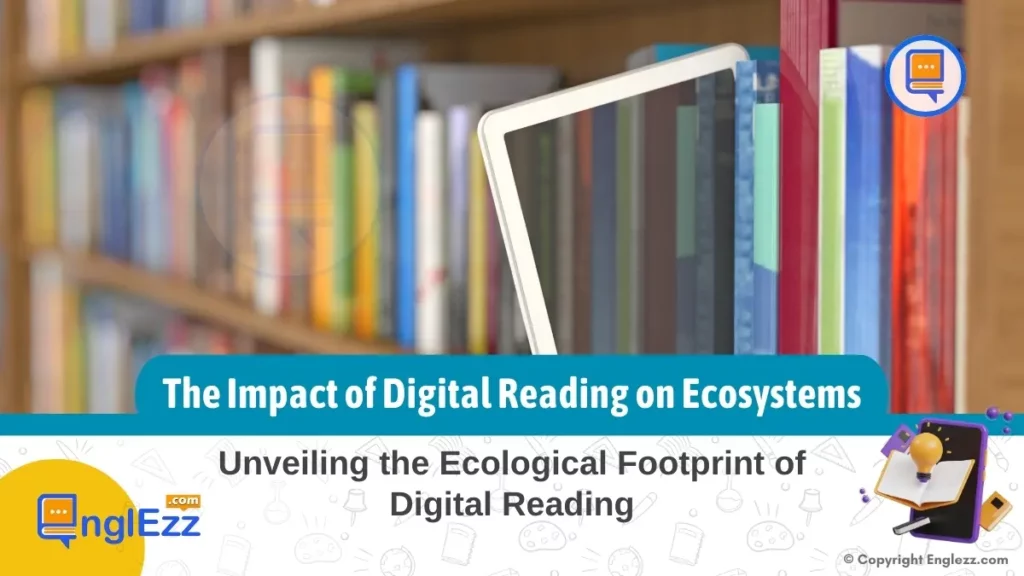The contemporary landscape of reading has undergone a profound transformation with the rise of digital platforms challenging traditional print paradigms. As readers navigate the realms of e-books and online publications, a crucial discourse emerges—unveiling the intricate ecological footprints that underlie these diverse reading practices.
The dichotomy between paper-based literature and digital texts not only encompasses matters of convenience and preference but delves deep into the environmental repercussions embedded within these choices. Understanding the dynamic interplay between digital versus print reading unveils a complex narrative where sustainability concerns intersect with evolving reading habits.
Table of Contents
- The Impact of Digital Reading on Ecosystems
- Ecological Impact of Print Reading
- Ecological Impact of Digital Reading
- Sustainable Reading Practices
- Educational Initiatives towards Eco-Literacy
- Future Prospects for Sustainable Reading Habits
- Exploration of the impact of digital reading on ecosystems
- Final Tips
- Final Thoughts
- FAQs
- Q: How does digital reading impact ecosystems differently from print readings?
- Q: What are some sustainable practices readers can adopt to reduce their ecological footprint?
- Q: Why is incorporating environmental studies in school curricula important in relation to reading habits?
- Q: What role do policymakers play in supporting sustainable reading initiatives?
- Q: How can collaboration between schools and libraries enhance eco-literacy among readers?
The Impact of Digital Reading on Ecosystems
In this scholarly exploration, we embark on a journey beyond mere comparison of paper and pixels, delving into nuanced dimensions that define the ecological impacts of our consumptive literary behaviors. As environmentalists advocate for sustainable living patterns, educators seek to instill eco-consciousness in their teachings, and book enthusiasts grapple with reconciling their love for literature with planetary preservation, it becomes imperative to dissect the multifaceted environmental implications inherent in our engagement with written content.
By unraveling the intricate threads that connect digital reading practices to ecosystems far beyond mere pages or screens, we shed light on an often overlooked aspect of literacy – one that demands informed contemplation and proactive engagement from all stakeholders invested in cultivating a greener future through mindful reading habits.
Ecological Impact of Print Reading
The ecological ramifications of print reading are intricately tied to the extensive deforestation activities associated with paper production for physical books. To put it into perspective, approximately 35% of harvested trees globally are utilized for paper manufacturing, leading to significant habitat destruction and biodiversity loss in forests. This process contributes substantially to greenhouse gas emissions and disrupts vital ecosystems that play a crucial role in carbon sequestration and climate regulation. Moreover, the waste generation from discarded print material exacerbates environmental concerns, as the disposal and decomposition of paper products release methane—a potent greenhouse gas—into the atmosphere.

When considering the carbon emissions entailed in printing and distributing physical books, a comprehensive life cycle assessment is imperative. From extraction and processing of raw materials to transportation and printing processes, each stage emits varying levels of greenhouse gases. For instance, a study conducted by environmental researchers highlighted that the production of a single paperback book generates approximately 7.5 kilograms of carbon dioxide equivalent (CO2eq), primarily due to energy-intensive printing techniques and transportation logistics involved in supplying books to readers worldwide. This revelation underscores the need for sustainable practices within the publishing industry to mitigate its ecological footprint effectively.
In essence, delving into the ecological impact of print reading reveals a complex web of interdependencies between forest degradation, waste accumulation, and carbon emissions. By shedding light on these critical aspects, stakeholders can make informed decisions regarding their reading habits while fostering a greater appreciation for environmentally conscious choices amidst the ever-evolving digital landscape.
Ecological Impact of Digital Reading
The shift towards digital reading has undeniably transformed the consumption landscape of literature, but its ecological implications warrant close scrutiny. One significant aspect is the generation of electronic waste stemming from devices utilized for accessing digital books. The rapid turnover in electronic gadgets driven by technological advancements not only contributes to mounting e-waste but also prompts concerns about the environmental repercussions of discarding outdated devices improperly. This escalating e-waste poses challenges in terms of recycling and disposal, highlighting the need for sustainable practices in managing electronic products to mitigate adverse impacts on ecosystems.
Moreover, an in-depth assessment of energy usage within digital book distribution networks sheds light on another facet of the ecological footprint associated with digital reading. The operation of servers hosting vast libraries of e-books, along with data transmission across various digital platforms, necessitates substantial energy consumption. Understanding and optimizing these energy-intensive processes are crucial for mitigating the environmental consequences arising from digital reading habits. Delving into this aspect reveals intricate layers of resource utilization and underscores the significance of adopting energy-efficient strategies in digitized reading ecosystems.
Comparing the carbon footprint between e-readers and physical books unveils nuanced insights into their respective ecological impacts. While conventional book publishing involves paper production, printing, and transportation contributing to greenhouse gas emissions, e-readers entail manufacturing processes utilizing resources like metals and plastics that come with their own environmental costs.
Evaluating these contrasting footprints offers a holistic perspective on the sustainability considerations surrounding reading preferences. By examining these interconnected factors, it becomes evident that informed choices regarding reading formats can play a pivotal role in shaping environmentally conscious behaviors within literary consumption paradigms.
Sustainable Reading Practices
In the realm of sustainable reading practices, embracing eco-friendly strategies is pivotal for reducing the environmental impact of reading habits. A fundamental step towards sustainability in print reading involves opting for books made from recycled or sustainably sourced paper. By choosing publications crafted from paper derived from responsible forestry practices or post-consumer waste, readers can actively support forest conservation initiatives and mitigate the depletion of natural resources. For example, many independent publishers are now prioritizing environmentally friendly paper options and promoting transparency regarding their sourcing methods to empower consumers to make informed decisions.
Moreover, addressing electronic waste generated by devices used for digital reading is essential in promoting sustainable habits among readers. Encouraging proper disposal and recycling of e-readers, tablets, and smartphones at the end of their lifecycle can significantly reduce the ecological footprint associated with digital reading technology. Initiatives that facilitate electronics recycling programs or provide incentives for returning old devices for refurbishment not only contribute to waste reduction but also promote a culture of responsible consumption within the digital reading community. For instance, partnering with electronics manufacturers to establish take-back programs can ensure that devices are recycled efficiently, preventing hazardous materials from contaminating ecosystems.
Embracing sustainable reading practices extends beyond individual actions to encompass collective efforts aimed at fostering a culture of environmental stewardship within reading communities. By advocating for book swaps, library rentals, or digital lending platforms, readers can actively engage in resource-sharing initiatives that minimize both paper consumption and electronic device turnover. Additionally, leveraging social media platforms or online forums to promote discussions on sustainable reading practices can inspire others to adopt eco-friendly behaviors in their literary pursuits.
Collaborative endeavors such as community book drives or local book exchange events further reinforce the importance of sustainability in reading while strengthening social bonds among like-minded individuals dedicated to preserving ecological integrity through conscientious consumption choices.
Educational Initiatives towards Eco-Literacy
In the wake of growing environmental concerns, advocating for the integration of comprehensive environmental studies into school curricula emerges as a pivotal step toward fostering eco-literate individuals. By including modules that delve into topics like ecological footprints within existing courses, students can cultivate a deeper understanding of how their reading habits impact ecosystems. For instance, illustrating the deforestation repercussions of traditional book publishing versus the electronic waste from e-readers could spark critical reflections on sustainable choices among students across various grade levels.
Digital Literacy Programs
Moreover, promoting digital literacy programs that specifically emphasize sustainable reading habits can amplify the reach and impact of eco-literacy initiatives in educational settings. Through these programs, educators can educate students on responsible consumption practices when engaging with digital reading materials. Incorporating lessons on the life cycles of e-devices used for reading could enhance awareness regarding proper disposal methods to mitigate electronic waste accumulation. Encouraging students to be mindful consumers in their digital reading practices fosters a sense of responsibility towards minimizing their ecological footprint.
Collaborative efforts between schools and libraries
Collaborative efforts between schools and libraries represent a promising avenue for instilling eco-conscious reading practices within communities. By establishing partnerships that champion environmentally friendly reading behaviors, such as sharing resources or organizing book swaps to reduce material consumption, institutions can collectively create a culture that values sustainability in literature consumption. Libraries playing an active role in hosting events centered around eco-friendly reading practices not only enrich community engagement but also sow seeds for long-term environmental stewardship among readers of all ages.
Future Prospects for Sustainable Reading Habits
As society progresses towards more sustainable practices, the realm of reading and publishing is also evolving to lessen the impact of digital reading on ecosystems. Looking ahead, advancements in eco-friendly printing technologies hold promise for reducing the environmental footprint of traditional book production. For instance, innovations in using plant-based or recycled materials for paper could significantly diminish the reliance on virgin wood pulp, thereby curbing deforestation rates associated with book printing. Additionally, developments in waterless printing techniques can lead to substantial conservation of water resources, aligning with sustainable production standards.
The future landscape of digital publishing is poised for trends that prioritize environmental stewardship. Forecasts indicate a shift towards increased use of renewable energy sources to power digital distribution networks, thus lowering carbon emissions generated during e-book dissemination. Furthermore, the development of e-reading devices with longer lifespan and upgradability features contributes to reducing electronic waste accumulation. By encouraging manufacturers to design gadgets with recyclable components and efficient energy consumption profiles, the digital reading sphere aims at fostering sustainability in its ecosystem.
In light of these advancements, it becomes imperative for policymakers to actively support sustainable reading initiatives through policy measures and incentives. Governments can play a pivotal role by promoting regulations that encourage publishers and readers alike to adopt eco-friendly practices. Subsidies for publishers using sustainable materials and tax benefits for consumers opting for electronic devices built for longevity are some strategies that can promote greener reading habits. By fostering a supportive legislative environment, policymakers can catalyze a cultural shift towards greater awareness and responsibility in the way we consume literature while preserving our precious ecosystems.
Exploration of the impact of digital reading on ecosystems
In this exploration of the impact of digital reading on ecosystems, it becomes evident that both print and digital reading practices have associated ecological footprints that merit consideration. While traditional print reading contributes to deforestation and waste generation, digital reading is not free from environmental consequences, with electronic waste and energy consumption posing challenges. Sustainable reading habits are essential for mitigating these impacts, prompting a shift towards eco-friendly practices like using recycled paper for print books and proper disposal of electronic devices.
Looking ahead, advancements in eco-friendly printing technologies offer hope for reducing the environmental toll of traditional publishing methods. Additionally, trends in digital publishing can further minimize carbon footprints through innovations in distribution networks and production processes. It is crucial for policymakers to support sustainable reading initiatives by incentivizing environmentally conscious practices within the publishing industry and among readers. By fostering a culture of eco-literacy and encouraging responsible consumption habits, we can work towards a more sustainable future for the literary world.
In conclusion, understanding the ecological footprint of our reading habits is paramount in addressing broader environmental concerns. By adopting sustainable reading practices at an individual level and advocating for systemic changes within the educational and publishing sectors, we can make meaningful strides towards reducing the environmental impact of our literary engagements. Through collaboration between stakeholders – including readers, educators, publishers, and policymakers – we can collectively contribute to preserving our ecosystems while continuing to enjoy the profound benefits of reading.
Final Tips
- As the world navigates towards more sustainable practices, there are several key tips readers can implement to reduce their ecological footprint when it comes to reading habits. Firstly, consider utilizing public libraries or digital library resources whenever possible. By borrowing books instead of purchasing or printing them, you can significantly decrease the demand for new materials and reduce waste generation. Additionally, making a conscious effort to opt for e-books over physical copies can lower carbon emissions associated with transportation and printing processes.
- Secondly, supporting publishers and authors that prioritize sustainability in their production methods is crucial. Look for eco-certifications or labels indicating the use of recycled materials in printed books or digital publishing platforms committed to minimizing environmental impacts. By choosing to engage with environmentally conscious literary sources, readers can contribute positively towards fostering a greener reading ecosystem.
- Lastly, individuals can actively participate in book exchange programs or book-sharing initiatives within communities. Sharing books among peers not only promotes social interactions but also promotes resource efficiency by reducing the need for multiple copies of the same book. Through collaborative efforts like community book swaps or online sharing platforms, readers can access a wide range of literature while minimizing their carbon footprint and environmental impact.
Final Thoughts
In the exploration of the ecological footprint of reading habits, this article delved into the contrasting impacts of print and digital reading on ecosystems. By examining factors such as deforestation, waste generation, carbon emissions, e-waste, and energy consumption associated with both mediums, it became evident that each mode of reading presents distinct environmental challenges. While print reading contributes to deforestation and paper waste, digital reading poses issues related to electronic waste and energy consumption in distribution networks.
As eco-conscious individuals, educators, and policymakers seek to mitigate the environmental repercussions of their reading habits and choices, sustainable practices emerge as a crucial facet in fostering a greener literary landscape. By advocating for eco-friendly printing technologies, promoting recycled or sustainably sourced materials, encouraging proper disposal and recycling of devices, incorporating environmental studies in educational curricula, and engaging in digital literacy programs emphasizing sustainable habits—the collective effort towards reducing the ecological footprint of reading can be significantly enhanced.
Through continued scholarly inquiry, collaborative endeavors among stakeholders across sectors—ranging from publishing industries to educational institutions—and informed decision-making influenced by empirical evidence and critical reflection, the path toward a more sustainable future for reading practices is paved with opportunities for innovation and positive change.
FAQs
Q: How does digital reading impact ecosystems differently from print readings?
A: Digital reading impacts ecosystems through e-waste generation from electronic devices used for reading along with energy consumption for maintaining digital platforms.
Q: What are some sustainable practices readers can adopt to reduce their ecological footprint?
A: Readers can opt for recycled or sustainably sourced paper for print books and ensure proper disposal and recycling methods for electronic devices.
Q: Why is incorporating environmental studies in school curricula important in relation to reading habits?
A: Environmental education raises awareness about ecological footprints associated with different types of readings, aiming to cultivate eco-conscious reading behaviors early on.
Q: What role do policymakers play in supporting sustainable reading initiatives?
A: Policymakers can contribute by promoting advancements in eco-friendly printing technologies, encouraging trends in digital publishing that reduce environmental impacts, and endorsing regulations favoring sustainable reading practices.
Q: How can collaboration between schools and libraries enhance eco-literacy among readers?
A: Collaboration opportunities between schools and libraries enrich eco-literacy efforts by jointly advocating for sustainable reading practices like using recycled materials or participating in digital literacy programs highlighting sustainability.








